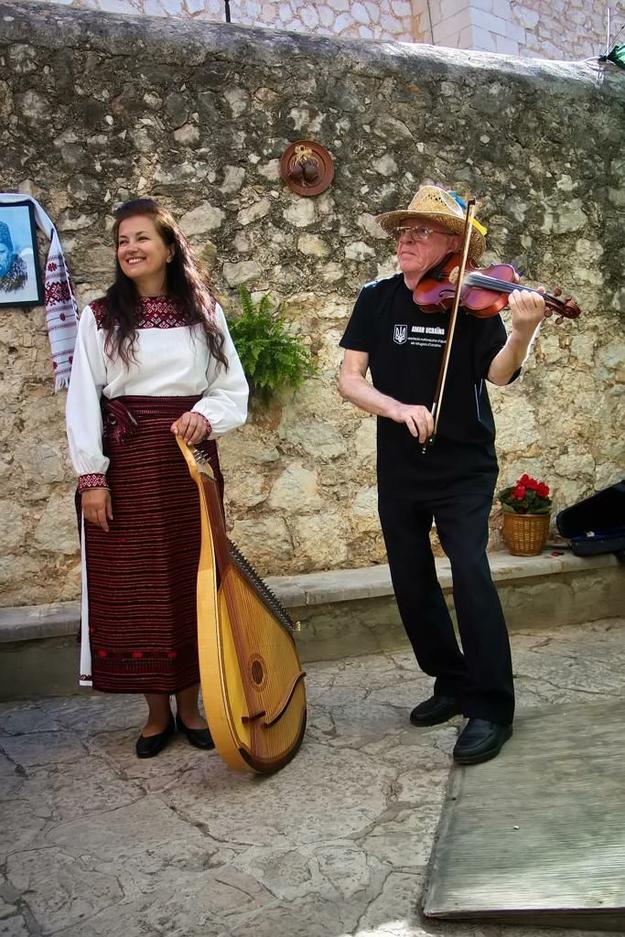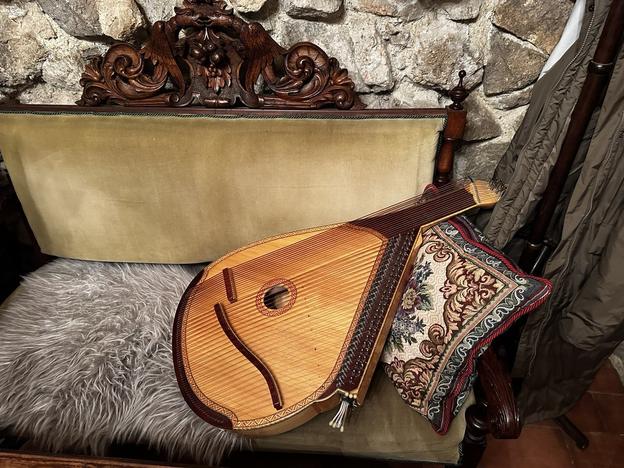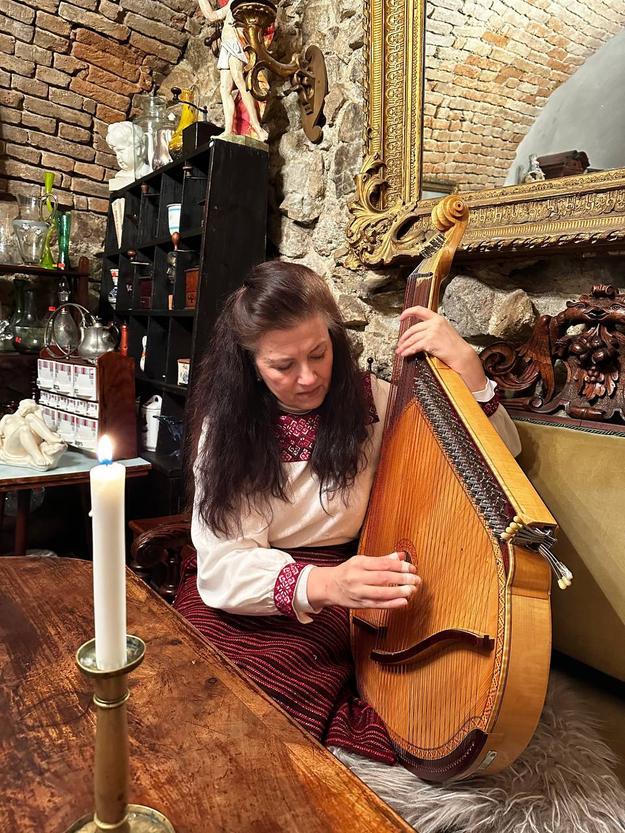This story is also available in Ukrainian and Slovak.
Last summer several days before her concert in Palma de Mallorca, the capital city of the Spanish island of Mallorca in the Mediterranean, Olga Smorkis was dealing with what at first seemed to her a small problem: One of the strings on her instrument, the bandura, broke.
All her local friends, old and new, soon began to contact music shops on the island, and even reached out to music shops in mainland Spain, so that Smorkis could play a concert for Ukrainian refugees on this Balearic island. But their efforts turned out in vain.
“There was no such string available in the shops. I had to order it all the way from Ukraine,” the artist tells The Slovak Spectator.
For Spanish musicians and audiences - like for artists and listeners from other countries - who aren’t very familiar with Ukrainian music and culture, the bandura is an instrument they’ve never seen or heard played before. The instrument, whose history dates to the 6th century, looks and sounds like the harp and the lute mixed together. However, to Ukrainians, it represents something more. It’s their national musical instrument. Even their voice, some would say.
“The bandura is an achievement of the Ukrainian people, an achievement of Ukrainian crafters and artists,” the Ukrainian bandurist says. That’s what she often tells people coming to her shows. People themselves often ask her about the bandura. “And I want to tell them more about it. Unfortunately, my English isn’t perfect.”
She admits that many Ukrainian people don’t know about the bandura either.
Recently, Smorkis performed on the streets of Bratislava’s Old Town. Like in Spain, she was again taken aback by the fact that local people didn’t know the instrument but still found it exciting to listen to. In Bratislava, she is currently rehearsing for the ‘Pearl Necklace of Music and Dance’ (Perlový náhrdelník hudba a tanca) show. It will showcase a part of Ukrainian culture, including the bandura, to the local crowd.
Struggle to pursue a music career
Born in Lyuboml, a town of 10,000 near the border with Poland and Belarus, Smorkis started to play the bandura at the age of 7. But after graduating from a local music school, her mother convinced her to become a teacher.
“She believed that was the best profession for her daughter,” she says.
Five years into her studies to become a music teacher at the Lesia Ukrainka East European National University in Lutsk, northwestern Ukraine, she realised that teaching wasn’t her dream. She picked up the bandura again after a long time and even finished second in a national bandurist contest for students. Nevertheless, her subsequent attempts to obtain a place at prestigious music colleges in Ukraine failed. Instead, she returned to Lyuboml, took up a teaching position, and continued participating in competitions and festivals.
It took Smorkis two years to enrol in one of Ukraine's music colleges.
However, after the artist graduated, she married and started her own family. As a result, she was forced to put her music career on hold to feed her family. It was in the late nineties that she began working as a seller of petroleum products.
Smorkis says that she couldn’t count on her musical family to support her career in music.
“Dad’s family sang so wonderfully! They had no music education, but when they gathered and started singing, it was like magic,” Smorkis recalls. Despite this, her father wasn’t happy about her dream of becoming a bandurist. “My dad had always said that being a musician was a difficult profession. He didn’t want me to do music.”
Instrument that can’t remain silent
Unlike Smorkis’ family, her husband supported her dream. However, the nature of his work required the family to move from one city to another. There was neither time nor energy, Smorkis says, to play the bandura.
Still, the passion for music didn’t abandon the Ukrainian.
It was her husband who, in 2002, suggested that she take part in a festival in Kosiv, western Ukraine. She followed his advice and eventually took home the grand prix, despite not having practised for several years. The win, she says, convinced her to not give up on her talent, but at the same time she knew that she would have to return to her daily routine and work in sales.
“I don’t understand why the work of an artist is so poorly paid in Ukraine,” she poses the question, not expecting a reply in return.
At one point, she caught herself thinking about where to get money from to buy a new bandura for herself. “I couldn’t find any answer,” Smorkis says. Her friend and her husband gifted her a new bandura in 2005 to develop her talent.
The instrument was made by the Lviv-based craftsman Vasyl Gerasymenko. And he asked the artist to do him a favour: to pass the bandura on to someone else if she feels like not playing it and singing anymore. He is convinced that the bandura just can’t be silenced, she explains.
Smorkis notes that one can’t just play music with the bandura, they also have to sing.
Part of Ukrainian history
The bandura is often mistaken for the kobza, which is a smaller instrument and has significantly fewer strings than the present-day bandura. The kobza was popular with Ukrainian warriors in the Middle Ages. Musicians playing the kobza and singing “dumy” (heroic songs about Ukrainian warriors) became known as “kobzari” or “singing Homers”.
The mediaeval instrument gradually evolved into the bandura, which can have up to 65 strings. It too became part of the Ukrainian identity.
However, under communism the Soviets tried to root out Ukrainian nationalism by destroying, among other things, Ukrainian culture. It is therefore no surprise to Smorkis that some Ukrainians don’t know the bandura.
“Once I was asked: ‘What instrument do you play? It’s the balalaika [a three-stringed Russian instrument of triangular shape], right?’” recalls the Ukrainian. “It’s very unfortunate to hear this because it shows how Soviet propaganda made people forget their history.”
That’s why Smorkis has never stopped telling people how important the role of bandura has been in the history of the Ukrainian people, and what an unique instrument it is.
From factory to stage
The musician moved to Slovakia in 2019 with her husband and three children. At first, they lived in Piešťany where her husband found a job. She worked in a factory producing clothes for forestry workers. The family later moved to Bratislava. Here, Smorkis had her Ukrainian diploma confirmed by state institutions, began to learn Slovak, and worked as a teacher in a local primary school.
But her passion for music also drove her to participate in several concerts. Her first concert in the city was held last autumn at Zichy Palace. Ahead of Christmas, she even organised a charity concert full of workshops, performances and exhibitions in cooperation with local and Ukrainian communities.
“The concert went so smoothly that it cannot be called anything other than a Christmas miracle,” the bandurist said.
This article was created thanks to the UNESCO programme "Supporting Ukrainian Refugees Through Mass Media", financed by the Japanese government.



 Olga Smorkis playing the bandura during a concert in DK Ružinov, Bratislava, on December 22, 2023. (source: Yury Krivosheya)
Olga Smorkis playing the bandura during a concert in DK Ružinov, Bratislava, on December 22, 2023. (source: Yury Krivosheya)
 Olga Smorkis and Michailo Galechka (violinist) during the concert in Palma de Mallorca. (source: O. S.)
Olga Smorkis and Michailo Galechka (violinist) during the concert in Palma de Mallorca. (source: O. S.)
 Olga Smorkis during a charity fair in Bratislava. (source: Yury Krivosheya)
Olga Smorkis during a charity fair in Bratislava. (source: Yury Krivosheya)
 A bandura. (source: Tamara Zinchenko)
A bandura. (source: Tamara Zinchenko)
 Olga Smorkis playing her bandura in Café L'Aura & Antik art shop. (source: Tamara Zinchenko)
Olga Smorkis playing her bandura in Café L'Aura & Antik art shop. (source: Tamara Zinchenko)